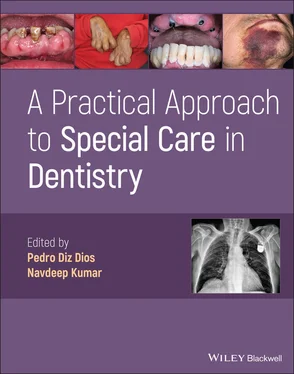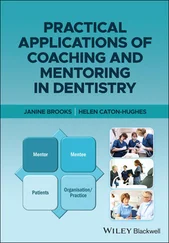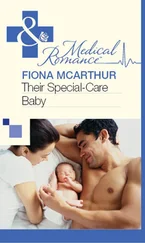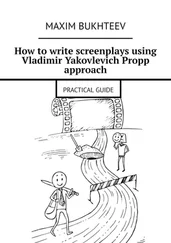A Practical Approach to Special Care in Dentistry
Здесь есть возможность читать онлайн «A Practical Approach to Special Care in Dentistry» — ознакомительный отрывок электронной книги совершенно бесплатно, а после прочтения отрывка купить полную версию. В некоторых случаях можно слушать аудио, скачать через торрент в формате fb2 и присутствует краткое содержание. Жанр: unrecognised, на английском языке. Описание произведения, (предисловие) а так же отзывы посетителей доступны на портале библиотеки ЛибКат.
- Название:A Practical Approach to Special Care in Dentistry
- Автор:
- Жанр:
- Год:неизвестен
- ISBN:нет данных
- Рейтинг книги:3 / 5. Голосов: 1
-
Избранное:Добавить в избранное
- Отзывы:
-
Ваша оценка:
- 60
- 1
- 2
- 3
- 4
- 5
A Practical Approach to Special Care in Dentistry: краткое содержание, описание и аннотация
Предлагаем к чтению аннотацию, описание, краткое содержание или предисловие (зависит от того, что написал сам автор книги «A Practical Approach to Special Care in Dentistry»). Если вы не нашли необходимую информацию о книге — напишите в комментариях, мы постараемся отыскать её.
Learn to treat dental patients with disabilities or who are medically compromised A Practical Approach to Special Care in Dentistry
A Practical Approach to Special Care in Dentistry
A Practical Approach to Special Care in Dentistry — читать онлайн ознакомительный отрывок
Ниже представлен текст книги, разбитый по страницам. Система сохранения места последней прочитанной страницы, позволяет с удобством читать онлайн бесплатно книгу «A Practical Approach to Special Care in Dentistry», без необходимости каждый раз заново искать на чём Вы остановились. Поставьте закладку, и сможете в любой момент перейти на страницу, на которой закончили чтение.
Интервал:
Закладка:
Patient diagnosed with myotonic muscular dystrophy, confirmed during the first days of life
Hypertrophic cardiomyopathy
Recurrent respiratory infections
Obstructive sleep apnea
Kyphoscoliosis
Hypermetropia (long‐sightedness)
Medications
Atenolol
Prednisone
Dental History
Good level of co‐operation
Regular dental attender (yearly)
No previous dental treatment received
Patient brushes his teeth on a regular basis without supervision
Social History
Mother deceased as a result of complications relating to the myopathy
Father estranged
Lives with his elderly grandparents, who are his primary care‐givers and are very protective of him
Requires specially arranged hospital transport to attend his appointments with both of his grandparents attending with him
Mild intellectual disability
Attends a public school
Oral Examination
Fair oral hygiene
Caries in #36 and #46
High‐arched/pointed (ogival) palate
Anterior open bite ( Figure 1.3.2)
Radiological Examination
Orthopantomogram – confirmed the clinical findings ( Figure 1.3.3)
Pattern of vertical mandibular growth (lateral cephalogram)
Structured Learning
1 What factors are considered important in assessing the risk of managing this patient?SocialTransport arrangements to attend dental appointmentsExcessive protectiveness by his guardians (the grandparents have already lost their daughter to the disease)MedicalMyotonic dystrophy type 1‐associated myotonia and multiorgan damage; muscle weakness, sleep disordersDiagnosis confirmed at birth is generally associated with a poor prognosisRisk resulting from cardiomyopathy and respiratory impairmentPosition in the dental chair compromised by the kyphoscoliosis Figure 1.3.1 Facial myopathy with severe open mouth. Figure 1.3.2 Anterior open bite.DentalRisk of aspiration during the dental procedureUnsupervised oral hygiene habitsFollow‐up difficulties due to social situation
2 The patient is taking prednisone at a dose of 20 mg/day. What are the implications of this when performing an invasive dental procedure?Delayed healing Figure 1.3.3 Lateral cephalogram showing a dolichocephalic growth pattern (relatively long skull).Increased risk of significant infectionAdrenal crisis may be triggered by surgical interventions due to chronic hypothalamic–pituitary–adrenal axis suppression – a corticosteroid supplementation protocol is required to prevent this (see Chapter 12.1)
3 What precautions should be undertaken in view of the patient's history of hypertrophic cardiomyopathy?Limit the administration of anaesthetics containing adrenaline and avoid intravascular injectionsSome cardiologists may disagree with international consensus guidelines, and hence recommend that these patients should receive antibiotic prophylaxis to prevent bacterial endocarditis if an invasive dental procedure is plannedA number of drugs, such as atenolol, can cause orthostatic hypotension
4 The patient's grandparents are insistent that an orthodontic appliance should be fitted as they feel that the palate is becoming more arched. What requirements should the patient satisfy before proceeding with orthodontic treatment?The oral hygiene should be extremely goodThe dentition should be stabilised, including restoration of #36 and #46The patient should be able to accept and tolerate both the intraoral and extraoral appliancesClose liaison with the medical team is required in order to evaluate the risk/benefit of proceeding, taking into account the progression of the muscular dystrophy
5 What type of appliances are recommended?In general, functional orthodontic devices are not recommended because the biological muscle forces are usually impairedDevices that may be prescribed for this patient include a palatal expander, multibracket appliances (for tooth alignment), a transpalatal bar with a stimulator/lingual pearl and/or a tongue guard and extraoral appliances such as a vertical traction chinguardHowever, due to the age of this patient, they may not be effective
6 What is the prognosis of the orthodontic treatment?The prognosis for the open bite and vertical mandibular growth is poorThe defect cannot be corrected in many patients, and the recurrence rate is high
7 Why are prevention and periodic follow‐up especially important for this patient?The patient will have increasing difficulty performing mechanical oral hygiene techniquesPhysiological mouth cleaning will worsen with timeThe bacterial load of the oral cavity can promote respiratory infectionsManaging the patient in the dental clinic will become increasingly complex
General Dental Considerations
Oral Findings
Difficulties in chewing, swallowing and phonation
Facial myopathy (hypotonia, dolichocephaly, open mouth) ( Figure 1.3.4a)
Malocclusion with anterior open bite, posterior cross‐bite and tendency to Angle class III ( Figure 1.3.4b)
Labial incompetence, mouth breathing, macroglossia and lingual protrusion
Tooth eruption delay
Agenesis, microdontia and hypoplasia, typically of the premolars Figure 1.3.4 (a) Facial myopathy (hypotonia, dolichocephaly and open mouth). (b) Malocclusion with anterior open bite.
Accumulation of dental plaque and calculus, leading to gingivitis
Bone disorders of the temporomandibular joint, limited mouth opening and occasional joint subluxation
Oral manifestations secondary to drugs such as corticosteroids, antiarrhythmic agents, tricyclic antidepressants, benzodiazepines and calcium antagonists
Dental Management
The dental treatment plan will be determined by the muscle groups involved, the disease severity and the patient's life expectancy ( Table 1.3.1)
Prevention is the key focus because the difficulties in performing dental procedures in these patients tend to worsen with time
Section II: Background Information and Guidelines
Definition
Muscular dystrophy consists of a heterogeneous group of hereditary diseases characterised by progressive weakness and impairment of skeletal muscles. These diseases are the main degenerative diseases in childhood. Duchenne muscular dystrophy is the most prevalent type, with 1 case per 3500 births, with no geographical or ethnic preferences.
Aetiopathogenesis
It has been suggested that muscular dystrophy is the result of a mutation in the genes that program critical proteins for muscle integrity, such as dystrophin
Dystrophin is found not only in skeletal muscle but also in the smooth and cardiac muscles, and also in the brain
The pattern of inheritance is variable:Sex‐linked muscular distrophies – Duchenne, Becker, Emery–DreifussAutosomal dominant – facioscapulohumeral, distal, ocular, oculopharyngealAutosomal recessive – limb‐girdle form
Clinical Presentation
There are more than 30 different types of muscular dystrophy, which vary in symptoms and severity
There are nine different categories used for diagnosis ( Table 1.3.2)
The clinical manifestations are determined by the type of muscular dystrophy Table 1.3.1 Considerations for dental management.Risk assessmentProgressive deterioration/poor prognosis (depending on the subtype)Comorbidities may be present (e.g. cardiomyopathy, arrhythmia, hypoventilation and neuropsychiatric disorders)Aspiration risk due to the loss of protective reflexesPressure ulcers (decubitus) may be presentLong‐term use of corticosteroids can result in adrenocortical suppressionRisk of rhabdomyolysis associated with general anaesthesiaCriteria for referralPatients can often be treated in a conventional dental clinic, especially during the initial stages of the diseaseReferral to a specialised clinic or hospital centre is determined by the patient's general condition (e.g. respiratory distress, severe heart disease and highly advanced stages of the disease)Patients with severe muscle contractures and/or medical complications should typically be treated in a hospital settingAccess/positionPhysical assistance for the transferOrthopaedic devices may be wornWheelchair use is commonShort sessions (frequent changes in position)Dental chair positioned at 45°In advanced phases of the disease, emergency dental care may be provided in a home (domiciliary) or hospital settingCommunicationA consultation with the patient's doctor is advisable to determine the degree of disease control and the presence of complicationsOccasionally, the disease is accompanied by intellectual disabilityVerbal communication may be impeded due to dysarthria among their manifestations (e.g. oculopharyngeal muscular dystrophy)Consent/capacityIn most cases, capacity is not impairedInform the patient that the dental treatment plan will need to consider the expected progression and life expectancy in relation to the muscular dystrophyAnaesthesia/sedationLocal anaesthesiaCaution is advised when using local anaesthesia with vasoconstrictors in patients with cardiomyopathy and arrhythmiasSedationAvoid opioids and benzodiazepines for conscious sedation (respiratory depression)General anaesthesiaMay be contraindicated in cases of cardiomyopathy or severe respiratory diseaseEndotracheal intubation can be challenging (due to kyphoscoliosis or neck flexion)Neuromuscular blockers and some inhaled anaesthetics produce respiratory depressionSuccinylcholine administration in patients with Duchenne and Becker muscular dystrophies is associated with life‐threatening rhabdomyolysis and hyperkalaemiaRisk of regurgitation, prolonged hypoventilation and aspiration pneumonia post intubationDental treatmentBeforeAssess the requirement for corticosteroid supplementationAssess the need for mouth propsOrthodontic therapy to improve the chewing function and the airway may be consideredRehabilitation with tooth‐supported and implant‐supported prostheses may be considered (isolated cases have been published)DuringIf mouth opening is impaired, consider careful use of mouth props (exercise increased caution as protective reflexes may be lost)Use rubber dam (decreased protective reflexes)Use a high‐volume suction to prevent aspirationAfterEnsure that the oral cavity is clear of all debrisDrug prescriptionConsider drug interactions with medications used to treat comorbidities (e.g. selective serotonin reuptake inhibitors inhibit several families of hepatic enzymes, which may delay the biotransformation of codeine to its active metabolite)Education/preventionDifficulties maintaining good mechanical oral hygieneDietary counsellingConsider the use of topical fluoride and fluoride varnishFissure sealants may be consideredEstablish regular check‐up visits to control plaque/tartar – increase frequency as muscular control deteriorates
Читать дальшеИнтервал:
Закладка:
Похожие книги на «A Practical Approach to Special Care in Dentistry»
Представляем Вашему вниманию похожие книги на «A Practical Approach to Special Care in Dentistry» списком для выбора. Мы отобрали схожую по названию и смыслу литературу в надежде предоставить читателям больше вариантов отыскать новые, интересные, ещё непрочитанные произведения.
Обсуждение, отзывы о книге «A Practical Approach to Special Care in Dentistry» и просто собственные мнения читателей. Оставьте ваши комментарии, напишите, что Вы думаете о произведении, его смысле или главных героях. Укажите что конкретно понравилось, а что нет, и почему Вы так считаете.












